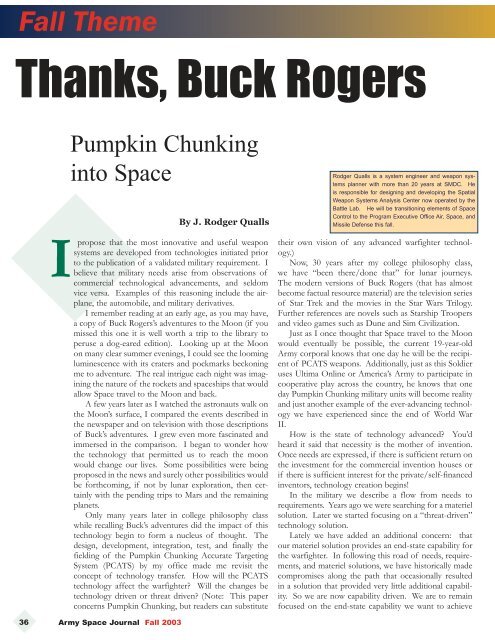Volume 2, Number 4 - Space and Missile Defense Command - U.S. ...
Volume 2, Number 4 - Space and Missile Defense Command - U.S. ...
Volume 2, Number 4 - Space and Missile Defense Command - U.S. ...
You also want an ePaper? Increase the reach of your titles
YUMPU automatically turns print PDFs into web optimized ePapers that Google loves.
Fall Theme<br />
Thanks, Buck Rogers<br />
Pumpkin Chunking<br />
into <strong>Space</strong><br />
By J. Rodger Qualls<br />
Ipropose that the most innovative <strong>and</strong> useful weapon<br />
systems are developed from technologies initiated prior<br />
to the publication of a validated military requirement. I<br />
believe that military needs arise from observations of<br />
commercial technological advancements, <strong>and</strong> seldom<br />
vice versa. Examples of this reasoning include the airplane,<br />
the automobile, <strong>and</strong> military derivatives.<br />
I remember reading at an early age, as you may have,<br />
a copy of Buck Rogers’s adventures to the Moon (if you<br />
missed this one it is well worth a trip to the library to<br />
peruse a dog-eared edition). Looking up at the Moon<br />
on many clear summer evenings, I could see the looming<br />
luminescence with its craters <strong>and</strong> pockmarks beckoning<br />
me to adventure. The real intrigue each night was imagining<br />
the nature of the rockets <strong>and</strong> spaceships that would<br />
allow <strong>Space</strong> travel to the Moon <strong>and</strong> back.<br />
A few years later as I watched the astronauts walk on<br />
the Moon’s surface, I compared the events described in<br />
the newspaper <strong>and</strong> on television with those descriptions<br />
of Buck’s adventures. I grew even more fascinated <strong>and</strong><br />
immersed in the comparison. I began to wonder how<br />
the technology that permitted us to reach the moon<br />
would change our lives. Some possibilities were being<br />
proposed in the news <strong>and</strong> surely other possibilities would<br />
be forthcoming, if not by lunar exploration, then certainly<br />
with the pending trips to Mars <strong>and</strong> the remaining<br />
planets.<br />
Only many years later in college philosophy class<br />
while recalling Buck’s adventures did the impact of this<br />
technology begin to form a nucleus of thought. The<br />
design, development, integration, test, <strong>and</strong> finally the<br />
fielding of the Pumpkin Chunking Accurate Targeting<br />
System (PCATS) by my office made me revisit the<br />
concept of technology transfer. How will the PCATS<br />
technology affect the warfighter? Will the changes be<br />
technology driven or threat driven? (Note: This paper<br />
concerns Pumpkin Chunking, but readers can substitute<br />
Rodger Qualls is a system engineer <strong>and</strong> weapon systems<br />
planner with more than 20 years at SMDC. He<br />
is responsible for designing <strong>and</strong> developing the Spatial<br />
Weapon Systems Analysis Center now operated by the<br />
Battle Lab. He will be transitioning elements of <strong>Space</strong><br />
Control to the Program Executive Office Air, <strong>Space</strong>, <strong>and</strong><br />
<strong>Missile</strong> <strong>Defense</strong> this fall.<br />
their own vision of any advanced warfighter technology.)<br />
Now, 30 years after my college philosophy class,<br />
we have “been there/done that” for lunar journeys.<br />
The modern versions of Buck Rogers (that has almost<br />
become factual resource material) are the television series<br />
of Star Trek <strong>and</strong> the movies in the Star Wars Trilogy.<br />
Further references are novels such as Starship Troopers<br />
<strong>and</strong> video games such as Dune <strong>and</strong> Sim Civilization.<br />
Just as I once thought that <strong>Space</strong> travel to the Moon<br />
would eventually be possible, the current 19-year-old<br />
Army corporal knows that one day he will be the recipient<br />
of PCATS weapons. Additionally, just as this Soldier<br />
uses Ultima Online or America’s Army to participate in<br />
cooperative play across the country, he knows that one<br />
day Pumpkin Chunking military units will become reality<br />
<strong>and</strong> just another example of the ever-advancing technology<br />
we have experienced since the end of World War<br />
II.<br />
How is the state of technology advanced? You’d<br />
heard it said that necessity is the mother of invention.<br />
Once needs are expressed, if there is sufficient return on<br />
the investment for the commercial invention houses or<br />
if there is sufficient interest for the private/self-financed<br />
inventors, technology creation begins!<br />
In the military we describe a flow from needs to<br />
requirements. Years ago we were searching for a materiel<br />
solution. Later we started focusing on a “threat-driven”<br />
technology solution.<br />
Lately we have added an additional concern: that<br />
our materiel solution provides an end-state capability for<br />
the warfighter. In following this road of needs, requirements,<br />
<strong>and</strong> materiel solutions, we have historically made<br />
compromises along the path that occasionally resulted<br />
in a solution that provided very little additional capability.<br />
So we are now capability driven. We are to remain<br />
focused on the end-state capability we want to achieve<br />
36<br />
Army <strong>Space</strong> Journal Fall 2003

















